|
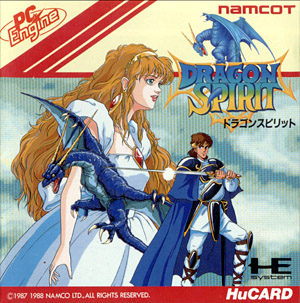
|

|
|
ドラゴンスピリット
©1987 1988 Namco Ltd
Release : 1988-12-16 (¥5500)
HuCard (2 Mbits) NC63003
Shooter / Vertical
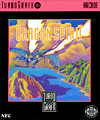

|
Released in America as
DRAGON SPIRIT
( TGX020016 )
|
|
Dragon spirit is a vertical shooter by namco and conversion of the
arcade game of the same name originally released in 1987. Alicia, the
princess of the Mitgult kingdom, has been kidnaped by the demonic serpent
king Zawel. Learning of her kidnaping, a courageous knight called Amul
comes to her rescue. The young warrior begs the heavens to usher him into his quest,
and , as he is about to start his journey, he points his sword to the sky and a
lightning bolt turns him into a powerful and great fire-breathing blue dragon.
Dragon spirit uses a gameplay formula laid down by other Namco's
classics such as Xevious - the dragon can fire upon air and ground targets
alike, giving the action additional strategy and depth. Additionally, two kinds of
colored magic eggs are scattered throughout the game - bombs can crack them open,
thus releasing two power-orbs, Increased Power (red) or
Additional Head/Increased Firepower (blue). Although the blue upgrades
automatically add a head to the dragon (and increase its firepower up to three
times total), the red power-orbs need to be collected in groups of three before
they do. Additionally, flashing enemies release all kind of special items when killed,
from alternate dragon forms, Speed Ups (S), Three Way Shots (W),
Multi Way Shots (X), Power-Down (skull) or Extra Lives
(three have to be collected though, and they come in the shape of dragon eggs
that need to hatch). Dragon spirit consists of eight levels
and is single-player only.
|
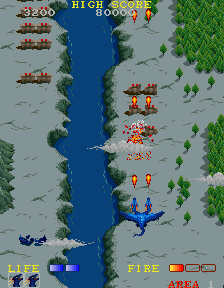 Dragon Spirit was an arcade game originally released in 1987 (it is interesting to
notice that it was distributed in the United States by Atari, who also distributed
Xevious in 1982). Apparently, the game was available in two versions (known as 'old'
and 'new') - the first one (and the earliest) is normal, whereas the second version
(more recent) features a stage selection menu at the beginning of the game. This is just
a wild guess, but maybe Namco realized that the brutal difficulty of the original
game (which features no continues!) limited its popularity and success, so it
wouldn't be a too much of a stretch to suggest that Namco decided to release the second version to
make the arcade game more exciting and appealing... Dragon Spirit was ported to
several home systems at the time, such as the Sharp X68000 (1987), PC Engine (1988),
Amstrad CPC (1989), Commodore 64 (1989), Commodore Amiga (1989),
Atari ST (1989) and ZX Spectrum (1990). The game
was also converted to the Famicom system in 1989 and renamed
Dragon Spirit : Aratanaru Densetsu
(aka "The New Legend"), and this version is more a pseudo-sequel to the original
game and stars Alicia and Amul's son. Two other games are worth
mentioning - the Namco Museum Vol.5 compilation released for the
Playstation in 1997 includes the original Dragon Spirit arcade game,
and an obscure LCD game also exists (maybe released in 1987 ?). Three year
later, in 1990, Namco released Dragon Saber, the official sequel to
Dragon Spirit. The game looks overall much better than its predecessor and it
addresses many of the difficulty issues, but the most notable additions are
the two-player simultaneous option and the power-shot dragons can charge
up and release for maximum damage. Curiously, Dragon Saber was only
converted to home systems in Japan - for the
PC Engine (1991) and later
included in Namco Museum Encore (Playstation, 1997).
Dragon Spirit was an arcade game originally released in 1987 (it is interesting to
notice that it was distributed in the United States by Atari, who also distributed
Xevious in 1982). Apparently, the game was available in two versions (known as 'old'
and 'new') - the first one (and the earliest) is normal, whereas the second version
(more recent) features a stage selection menu at the beginning of the game. This is just
a wild guess, but maybe Namco realized that the brutal difficulty of the original
game (which features no continues!) limited its popularity and success, so it
wouldn't be a too much of a stretch to suggest that Namco decided to release the second version to
make the arcade game more exciting and appealing... Dragon Spirit was ported to
several home systems at the time, such as the Sharp X68000 (1987), PC Engine (1988),
Amstrad CPC (1989), Commodore 64 (1989), Commodore Amiga (1989),
Atari ST (1989) and ZX Spectrum (1990). The game
was also converted to the Famicom system in 1989 and renamed
Dragon Spirit : Aratanaru Densetsu
(aka "The New Legend"), and this version is more a pseudo-sequel to the original
game and stars Alicia and Amul's son. Two other games are worth
mentioning - the Namco Museum Vol.5 compilation released for the
Playstation in 1997 includes the original Dragon Spirit arcade game,
and an obscure LCD game also exists (maybe released in 1987 ?). Three year
later, in 1990, Namco released Dragon Saber, the official sequel to
Dragon Spirit. The game looks overall much better than its predecessor and it
addresses many of the difficulty issues, but the most notable additions are
the two-player simultaneous option and the power-shot dragons can charge
up and release for maximum damage. Curiously, Dragon Saber was only
converted to home systems in Japan - for the
PC Engine (1991) and later
included in Namco Museum Encore (Playstation, 1997).
|
|
This PC Engine version of Dragon Spirit is very faithful to the
original arcade game, however it shows some notable differences. Namco
must have had some problems fitting the game onto a 2 Mbits HuCard and they had
to cut some content from the original arcade game. The most obvious is the
omission of the short introduction sequence, where Amul raises his sword
to the sky and transforms into a dragon - although it is one of Dragon Spirit's
signature feature (and was even included in the Famicom port!), it was
completely removed from the PC Engine version. Finally, some of the later
levels didn't make the cut - the seventh (underwater ocean) and eight levels
(ocean trench) are gone and were replaced by a castle level which ends with a
new boss (a three headed golden monster based on the first boss).
|
|
Can we talk about Dragon Spirit and not mention Shinji Hosoe ?
The artist behind the game's excellent soundtrack ? Interestingly, he joined
Namco as a part-time game tester and the arcade game Dragon Spirit
was his first project (and breakthrough) as a musician - but, in an interview,
he mentioned that although his composition experience began there, Namco
didn't know he was writing music and he was doing it secretly (he was supposed
to be a part-time CG Artist). But it was the beginning of a long and outstanding
career, and he composed a variety of other memorable soundtracks, most of them
praised with their own audio album releases! He left Namco in 1996
(after finishing the score for Xevious 3D/G), and decided to pursue his
own musical career (for instance he created the indie record label
Troubadour Records and the music production company and label
SuperSweep). His career is the subject of a vast and still-expanding
library, and he composed some truly memorable soundtracks, such as
Ordyne, Dragon Saber, Galaxian 3, Star Blade,
Cyber Sled, Ridge racer, Xevious 3D/G,
Street Fighter EX 3, Beat Mania, Xenosaga Episode II,
Folklore or Ibara.
|
Teaser text from the American version:
Amur, the spirit of the dragon, lives within you. As the winged creature that breathes
mega-tons of fire, your mission is revealed. Rescue Princess Alicia from Zowel, Demon of
Darkness. So take to the skies and destroy enemy creatures with breath and fireballs. Add
dragon heads and incredible power ups. Confront Zowel in a Super Battle of Beasts!
(Careful not to breathe on Alicia).
|
Game Staff (Copied from the end credits) :
STAFF
Character Design
Macchan
Arakawa Da!
Music Composer
Megaten Hosoe
Astron Ishii
Kawagen
Thunder Nogushi
Main Programmer
Otenba Kid
Guest Programmer
Hal/Uda
Sound Programmer
Yoshi Kabasan
Producer
Greatist Asayan
|
|
Special Thanks to
Kyonta
Kazuchan
Yohkun
Omake!
<<1984>>
Galaxian
Pac-Man
Xevious
Mappy
<<1985>>
Galaga
Digdug
The Tower Of Druaga
Warpman
Battle City
Pac-Land
Burger Time
Star Luster
<<1986>>
Digdug2
Tag Team Prowrestling
|
|
Super Chinese
Babel
Valkyrie
Skykid
Super Xevious
Mappy-Land
Family Stadium
Metrocross
<<1987>>
Dragon Buster
Family Jockey
Sanma No Meitantei
Dragonslayer4
Family Boxing
Family Mahjong
Digital Devil Story
Side Pocket
Lupin The 3rd
Devious
Karnov
Family Stadium'97
Family Tennis
|
|
Star Wars
<<1988>>
Family Circuit
Yokai Douchuki
Dokuganeyu Masamune
World Stadium
Namco Classic
Youkai Douchuki
Galaga'88
The quest of Ki
Sangokushi
World Court
and
Dragon Spirit
The end
Presented by Namco
|
|
S
E
C
R
E
T
S
|
|
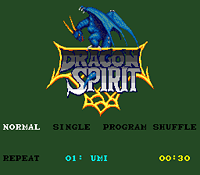 Arcade mode:
Arcade mode:
Hold Select and press Run to reset the game. Do
this operation fifty seven times (you can just hold select
and keep pressing Run) to start the game in arcade mode.
Sound Test Screen:
At the title screen, press Left, Right, Down,
Up, Select and Left. This should open the
Sound Test screen (picture on the right).
Hundred Continues:
At the title screen, quickly press Down, Right, Select,
Down, II, Down, I, Left, Select,
Up and I. A sound should confirm that the
cheat has been activated.
|
G
O
O
D
I
E
S
|
|
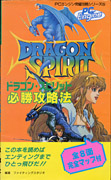
Japanese Guidebook
|
|
|
O
M
A
K
E
|
|
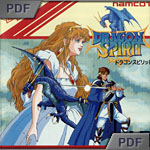
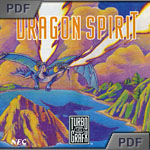


|
|
|
Click on picture to enlarge |
|
|
|
LK

|
|
Add your Pov here !
|
P
O
V
s
|
|
Dragon Spirit is excellent. The difficulty level
is well balanced (easier and more enjoyable than the original
arcade game in my opinion), the music scores are gorgeous and
the graphics are fairly good for a game released in 1988 (though
some backgrounds look a bit undefined and flat in places).
Namco decided to steer away from the norm and tried to
provide freshness and originality to a genre dominated by space
aliens and asteroid fields - and they succeeded for sure. As
aforementioned, the game is easier than the original arcade
game and I can only applaud this decision - it is not always
a good idea to faithfully convert an arcade game difficulty
level, especially when it was originally tuned up to gulp down
coins (yes, I'm looking at you, Capcom, and your
Makaimura series!). It is not to say that this port
is easy, and it'll be a long while before you see the end of
it! All in all, Dragon Spirit is a great shooter and
although I prefer its sequel (Dragon Saber), it is still
a solid game with a strong gameplay and some very innovative
ideas for its time.
|
|
|
|